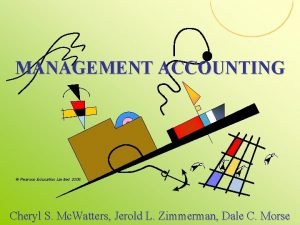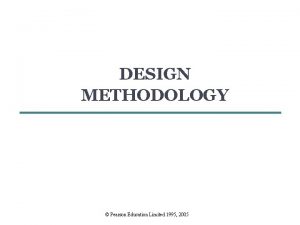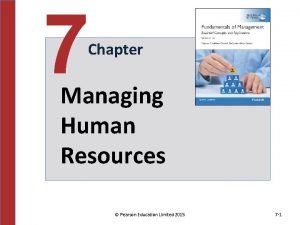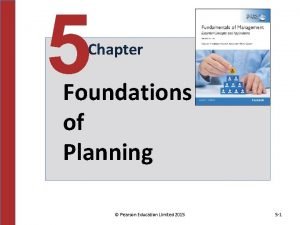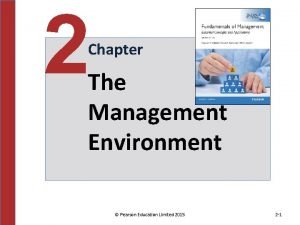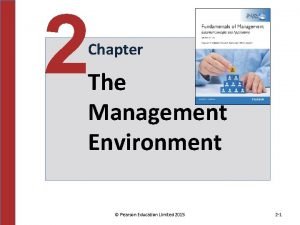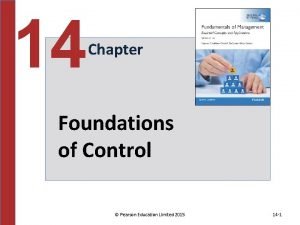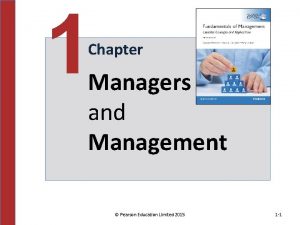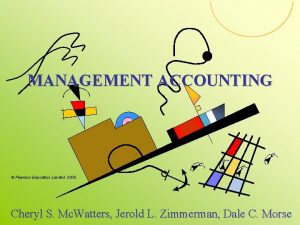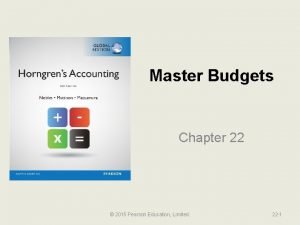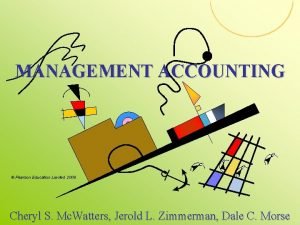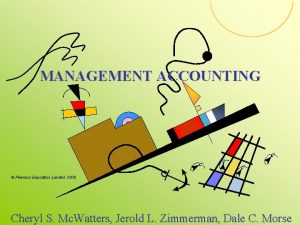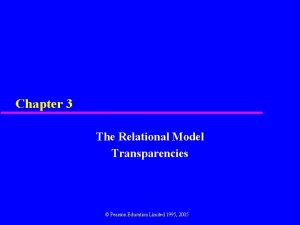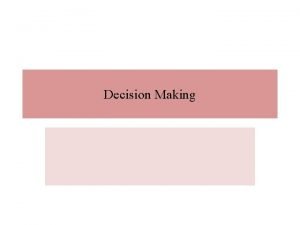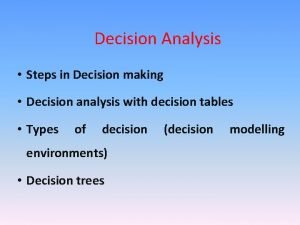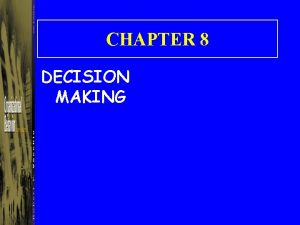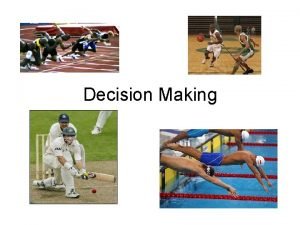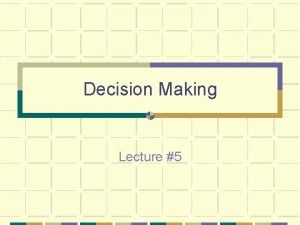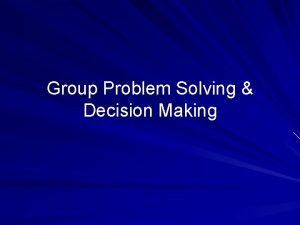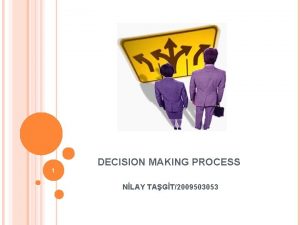4 Foundations of Decision Making Pearson Education Limited


























- Slides: 26

4 Foundations of Decision Making © Pearson Education Limited 2015 Chapter 4 -1

Learning Outcomes the decision-making process. Explain the three approaches managers can use to make decisions. Describe the types of decisions and decision -making conditions managers face. Discuss group decision-making. contemporary issues in managerial decision making. © Pearson Education Limited 2015 Describe 4 -2

4 -3 decision-making process. © Pearson Education Limited 2015 4. 1 Describe the

How Do Managers Make Decisions? 4 -4 © Pearson Education Limited 2015

Identifying a Decision Problem a discrepancy between an existing and a desired state of affairs. © Pearson Education Limited 2015 Step 1: Identification of Problem: 4 -5

Identifying Decision Criteria Price Model Size Manufacturer Options Repair record © Pearson Education Limited 2015 Step 2: İdentify the Relevant Factors: 4 -6

Step 3: Weighting Criteria Most important criterion assigned a weight of 10. 2. Other weights assigned against this standard. © Pearson Education Limited 2015 1. 4 -7

Step 4: Developing Alternatives 4 -8 © Pearson Education Limited 2015

Step 5: Analyzing Alternatives 4 -9 © Pearson Education Limited 2015

4 -10 © Pearson Education Limited 2015 Step 6: Selecting the Best Alternative

Step 7: Implementing the Decision putting a decision into action. © Pearson Education Limited 2015 Decision implementation: 4 -11

Step 8: Evaluating the Decision Was the problem resolved? © Pearson Education Limited 2015 Appraising the outcome of the decision: 4 -12

4 -13 Common Errors © Pearson Education Limited 2015

4 -14 of decisions and decision-making conditions that managers face. © Pearson Education Limited 2015 4. 3 Describe the types

Types of Problems 4 -15 2. Unstructured problem Problems—that is, situations that are new or unusual and for which information is ambiguous or incomplete. Entering a new market segment or deciding to invest in an unproven technology are examples of unstructured problems. © Pearson Education Limited 2015 1. Structured problem The goal of the decision maker is clear, the problem familiar, and information about the problem easily defined and complete. Examples include a customer who wants to return an online purchase or a TV news team that has to respond to a fast-breaking event. These situations are called structured problems because they align closely with the assumptions that underlie perfect rationality.

Types of Decisions For example, what does a manager do if an auto mechanic damages a customer’s rim while changing a tire? Because the company probably has a standardized method for handling this type of problem, it’s considered a programmed decision, which tends to rely heavily on previous solutions—such as replacing the rim at the company’s expense. Managers can use three guides for making programmed decisions: • Systematic procedures • Rules • Policies A procedure is a series of interrelated sequential steps that a manager can use when responding to a well-structured problem. © Pearson Education Limited 2015 1. Programmed(Routine): Repetitive decisions that can be handled using a routine approach. Programmed, or routine, decision making is the most efficient way to handle structured problems. 4 -16

Types of Decisions (cont. ) Repetitive decisions that can be handled using a routine approach. Examples of non-programmed decisions include deciding whether to acquire another organization or to sell off an unprofitable division. Such decisions are unique and nonrecurring so when a manager confronts an unstructured problem, no cut-and-dried solution is available. The creation of a new organizational strategy is a non-programmed decision. It is different from previous organizational decisions because the issue is new, a different set of environmental factors exists, and other conditions have changed. © Pearson Education Limited 2015 2. Non-programmed: 4 -17

4 -18 © Pearson Education Limited 2015 Problems, Decision Types, and Organizational Levels

Decision-Making Conditions Certainty: which is a situation where a manager can make accurate decisions because the outcome of every alternative is known. Risk: in which the decision maker is able to estimate the likelihood of certain outcomes based on data from past personal experiences or secondary information that lets the manager assign probabilities to different alternatives. Uncertainty: means that the decision maker is not certain about the outcomes and can’t even make reasonable probability estimates. The choice of alternatives is influenced by the limited amount of information and by the psychological orientation of the decision maker. © Pearson Education Limited 2015 4 -19

4 -20 Discuss group decision-making. © Pearson Education Limited 2015 4. 4

How Do Groups Make Decisions? Committees Task forces Review panels Work teams • • In many cases, these groups represent the people who will be most affected by the decisions being made because they are often the best qualified to make decisions that affect them. © Pearson Education Limited 2015 Decisions are often made by groups representing the people who will be most affected by those decisions. 4 -21

Advantages of Group Decision Making complete information Diversity More of experiences/perspectives alternatives generated Increased acceptance of solution Increased legitimacy © Pearson Education Limited 2015 More 4 -22

Time-consuming Minority domination Ambiguous Pressures responsibility to conform 4 -23 © Pearson Education Limited 2015 Disadvantages of Group Decision Making

Groupthink 4 -24 What it does How it occurs How to minimize it © Pearson Education Limited 2015 When a group exerts extensive pressure on an individual to withhold his or her different views in order to appear to be in agreement.

When Are Groups Most Effective? Group More accurate decisions More creative More heterogeneous representation Greater acceptance of final solution © Pearson Education Limited 2015 Individual Faster decision making More efficient use of work hours 4 -25

Improving Group Decision Making 1. Brainstorming 2. The nominal group technique 3. Electronic meetings © Pearson Education Limited 2015 Make group decisions more creative by: 4 -26
 Pearson education limited 2008
Pearson education limited 2008 Pearson education limited 2005
Pearson education limited 2005 Pearson education
Pearson education Copyright pearson education inc
Copyright pearson education inc Pearson education limited 2015
Pearson education limited 2015 Formal planning may create rigidity.
Formal planning may create rigidity. Pearson education limited 2015
Pearson education limited 2015 Pearson education limited 2015
Pearson education limited 2015 Pearson education limited 2015
Pearson education limited 2015 Pearson education limited 2015
Pearson education limited 2015 Pearson education limited 2015
Pearson education limited 2015 Pearson education limited 2008
Pearson education limited 2008 Pearson education limited 2015
Pearson education limited 2015 Pearson education limited 2015
Pearson education limited 2015 Pearson education limited 2008
Pearson education limited 2008 Master budget template
Master budget template Pearson education limited 2005
Pearson education limited 2005 No decision snap decision responsible decision
No decision snap decision responsible decision Slidetodoc.com
Slidetodoc.com Prentice hall publishing
Prentice hall publishing 2011 pearson education inc
2011 pearson education inc Pearson education inc publishing as pearson prentice hall
Pearson education inc publishing as pearson prentice hall Pearson 2012
Pearson 2012 Pearson education inc publishing as pearson prentice hall
Pearson education inc publishing as pearson prentice hall Ficks law
Ficks law Table based testing
Table based testing Pearson vue ceo
Pearson vue ceo
